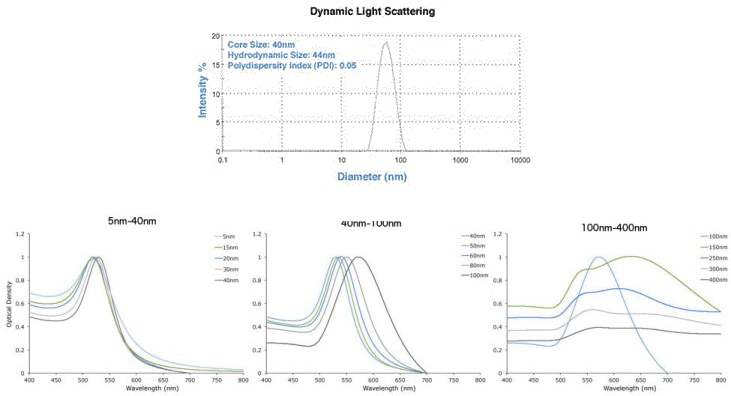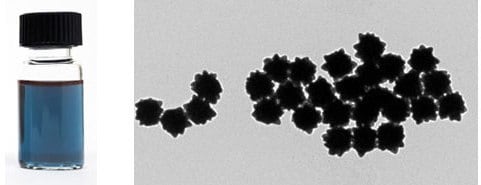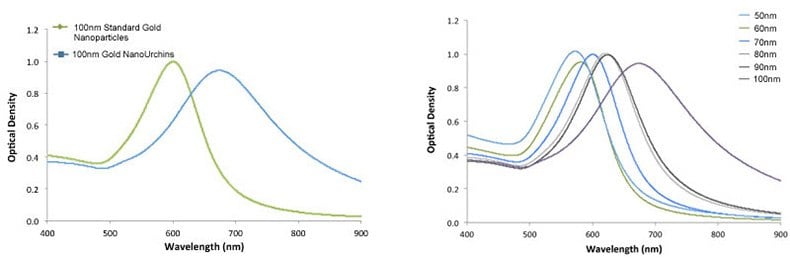Gold Nanoparticles: Properties and Applications
Introduction
Colloidal gold nanoparticles have been utilized for centuries by artists due to the vibrant colors produced by their interaction with visible light. More recently, these unique optoelectronic properties have been researched and utilized in high technology applications such as organic photovoltaics, sensory probes, therapeutic agents, drug delivery in biological and medical applications, electronic conductors and catalysis. The optical and electronic properties of gold nanoparticles are tunable by changing the size, shape, surface chemistry, or aggregation state.
Optical & Electronic Properties of Gold Nanoparticles
Gold nanoparticles’ interaction with light is strongly dictated by their environment, size and physical dimensions. Oscillating electric fields of a light ray propagating near a colloidal nanoparticle interact with the free electrons causing a concerted oscillation of electron charge that is in resonance with the frequency of visible light. These resonant oscillations are known as surface plasmons. For small (~30 nm) monodisperse gold nanoparticles, the surface plasmon resonance phenomenon causes an absorption of light in the blue-green portion of the spectrum (~450 nm) while red light (~700 nm) is reflected, yielding a rich red color. As particle size increases, the wavelength of surface plasmon resonance related absorption shifts to longer, redder wavelengths. Red light is then absorbed, and blue light is reflected, yielding solutions with a pale blue or purple color (Figure 1). As particle size continues to increase toward the bulk limit, surface plasmon resonance wavelengths move into the IR portion of the spectrum and most visible wavelengths are reflected, giving the nanoparticles clear or translucent color. The surface plasmon resonance can be tuned by varying the size or shape of the nanoparticles, leading to particles with tailored optical properties for different applications.

Figure 1.Colors of various sized monodispersed gold nanoparticles
This phenomenon is also seen when excess salt is added to the gold solution. The surface charge of the gold nanoparticle becomes neutral, causing nanoparticles to aggregate. As a result, the solution color changes from red to blue. To minimize aggregation, the versatile surface chemistry of gold nanoparticles allows them to be coated with polymers, small molecules, and biological recognition molecules. This surface modification enables gold nanoparticles to be used extensively in chemical, biological, engineering, and medical applications. Typical properties of gold nanoparticles are presented in Table 1.
Applications
The range of applications for gold nanoparticles is growing rapidly and includes:
- Electronics - Gold nanoparticles are designed for use as conductors from printable inks to electronic chips.1 As the world of electronics become smaller, nanoparticles are important components in chip design. Nanoscale gold nanoparticles are being used to connect resistors, conductors, and other elements of an electronic chip.
- Photodynamic Therapy - Near-IR absorbing gold nanoparticles (including gold nanoshells and nanorods) produce heat when excited by light at wavelengths from 700 to 800 nm. This enables these nanoparticles to eradicate targeted tumors.2 When light is applied to a tumor containing gold nanoparticles, the particles rapidly heat up, killing tumor cells in a treatment also known as hyperthermia therapy.
- Therapeutic Agent Delivery - Therapeutic agents can also be coated onto the surface of gold nanoparticles.3 The large surface area-to-volume ratio of gold nanoparticles enables their surface to be coated with hundreds of molecules (including therapeutics, targeting agents, and anti-fouling polymers).
- Sensors - Gold nanoparticles are used in a variety of sensors. For example, a colorimetric sensor based on gold nanoparticles can identify if foods are suitable for consumption.4 Other methods, such as surface enhanced Raman spectroscopy, exploit gold nanoparticles as substrates to enable the measurement of vibrational energies of chemical bonds. This strategy could also be used for the detection of proteins, pollutants, and other molecules label-free.
- Probes - Gold nanoparticles also scatter light and can produce an array of interesting colors under dark-field microscopy. The scattered colors of gold nanoparticles are currently used for biological imaging applications.5 Also, gold nanoparticles are relatively dense, making them useful as probes for transmission electron microscopy.
- Diagnostics - Gold nanoparticles are also used to detect biomarkers in the diagnosis of heart diseases, cancers, and infectious agents.6 They are also common in lateral flow immunoassays, a common household example being the home pregnancy test.
- Catalysis - Gold nanoparticles are used as catalysts in a number of chemical reactions.7 The surface of a gold nanoparticle can be used for selective oxidation or in certain cases the surface can reduce a reaction (nitrogen oxides). Gold nanoparticles are being developed for fuel cell applications. These technologies would be useful in the automotive and display industry.
Quality Advantage
In conjunction with Cytodiagnostics, we are proud to offer a broad portfolio of gold nanoparticles geared specifically for high-technology applications within the fields of life science and materials science. Gold nanoparticles are available in sizes ranging from 5 nm to 400 nm in diameter with numerous surface functionalities in a variety of solvent compositions.
While spherical gold nanoparticles are traditionally synthesized using reducing agents such as sodium citrate or sodium borohydride, Cytodiagnostics has a propriety process and formulation that leads to the preparation of highly spherical gold nanoparticles, without harsh reducing agents. When compared to other gold nanoparticles, these nanoparticles have many advantages, including:
- Narrow size distribution - based on Dynamic Light Scattering (DLS) and TEM analysis. Each batch is verified by DLS and UV-Vis spectroscopy (Figure 2).

Figure 2.DLS & UV-Vis spectra showing precise gold nanoparticles from Cytodiagnostics.
- Consistent Size and Shape — <10% CV (coefficient of variance) even above 100 nm. Example of 5 nm and 400 nm nanoparticles are shown below in Figure 3.

Figure 3.TEM images of 5 nm (left) and 400 nm (right) gold nanoparticles with <8% CV.
Gold NanoUrchins

Figure 4.TEM of 100 nm Gold NanoUrchins
Gold NanoUrchins have unique optical properties compared to spherical gold nanoparticles of the same core diameter. The spiky uneven surface causes a red shift in the surface plasmon peak and a larger enhancement of the electromagnetic field at the tips of the Gold NanoUrchin spikes compared to spherical particles. As an example, 100nm spherical gold nanoparticles have an SPR peak at 570nm while 100nm Gold NanoUrchins have a SPR peak at around 680nm, figure 4.

Figure 5.Left - UV-VIS spectra of 100 nm Gold NanoUrchins (blue) and 100 nm standard gold nanoparticles (green). Note the red-shift in the SPR-peak. Right - UV-VIS spectra of Gold NanoUrchins ranging in size from 50 nm to 100 nm in diameter.
Outlook
Gold nanoparticles are versatile materials for a broad range of applications with well characterized electronic and physical properties due to well-developed synthetic procedures. In addition, their surface chemistry is easy to modify. These features have made gold nanoparticles one of the most widely used nanomaterials for academic research and an integral component in point-of-care medical devices and industrial products worldwide. Our broad offering of gold nanoparticles, accessible to the global research community, serves to increase their adoption in high-technology applications.
References
如要继续阅读,请登录或创建帐户。
暂无帐户?